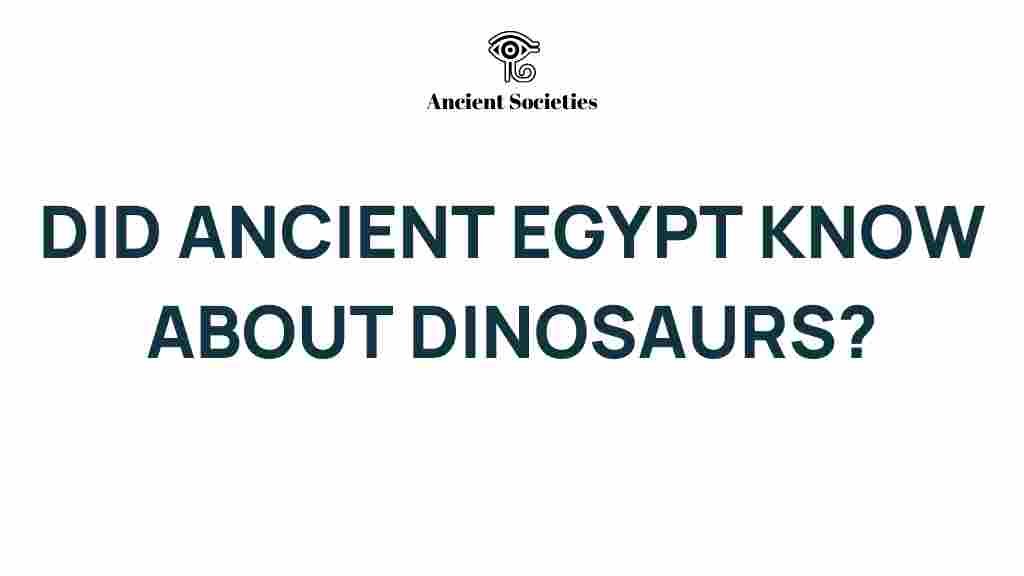Unveiling the Mystery: Did Ancient Egypt Know About Dinosaurs?
When we think of ancient civilizations, the marvels of Ancient Egypt often come to mind. With its grand pyramids, intricate hieroglyphs, and fascinating culture, Ancient Egypt has captivated the imagination of historians and archaeologists alike. But as we delve deeper into the history of this remarkable civilization, one intriguing question arises: Did Ancient Egypt know about dinosaurs? This article explores the intersection of Ancient Egypt, dinosaurs, archaeology, and cultural beliefs, shedding light on how these ancient people interacted with the remnants of the prehistoric past.
The Fascination with Dinosaurs in Modern Times
Before we can explore the potential knowledge of dinosaurs in Ancient Egypt, it’s essential to understand our contemporary relationship with these prehistoric creatures. The field of paleontology has advanced significantly over the years, leading to numerous discoveries of dinosaur fossils. These fossils have unveiled a wealth of information about the Earth’s history, evolution, and the extinction events that shaped the planet.
In modern times, dinosaurs have become a cultural phenomenon, inspiring books, movies, and even theme parks. However, the fascination with these great reptiles is not a new development. Ancient civilizations often encountered fossilized remains, leading to varied interpretations based on their cultural beliefs.
Archaeology and the Discovery of Fossils
The study of fossils is a crucial aspect of archaeology, and it provides insights into what ancient civilizations might have known about the creatures that roamed the Earth long before humans. In Egypt, the arid climate has preserved many remains, allowing archaeologists to uncover a wealth of information about ancient life.
- Fossil Discoveries in Egypt: Various fossils have been discovered in the Egyptian desert, including those of prehistoric reptiles and mammals.
- Interpretations of Fossils: Ancient Egyptians may have encountered these fossils, leading them to create myths and legends that intertwined with their understanding of the world.
Ancient Egypt and Its Cultural Beliefs
The ancient Egyptians had a rich tapestry of beliefs regarding the afterlife, gods, and the natural world. Their understanding of large bones or fossilized remains could have been influenced by their cultural context. Here are some key points:
- Mythological Interpretations: Large bones might have been attributed to mythical creatures or gods. For example, the ancient Egyptians worshipped various deities, some of which were depicted with animal features.
- Symbolism in Art: The presence of large animal figures in their art could indicate a recognition of large creatures, possibly inspired by fossils.
Scientific Discoveries and Ancient Knowledge
While it is unlikely that Ancient Egyptians understood dinosaurs in the scientific sense we do today, there is evidence to suggest that they interacted with the remnants of these creatures. The following sections delve into the archaeological findings that support these claims:
1. Fossilized Remains and Ancient Texts
Archaeologists have discovered several fossilized remains in Egypt. Some of these fossils date back to the Mesozoic era, the age of dinosaurs. Ancient texts, such as hieroglyphs, may provide insights into how these remains were perceived:
- Hieroglyphic Records: Some hieroglyphs depict large animals that resemble dinosaurs, raising questions about their origin and whether they were inspired by real fossils.
- Literature and Myths: Ancient Egyptian literature often includes references to large creatures, which could be interpreted as nods to the existence of dinosaurs.
2. Connections to Other Ancient Civilizations
Other ancient civilizations, such as the Greeks and Romans, also encountered fossils and developed their interpretations. Ancient Egyptians were known to trade and communicate with these cultures, potentially leading to shared knowledge about large bones found in the Earth.
Exploring the Evidence: Did They Know?
The evidence supporting the notion that Ancient Egyptians had some awareness of large prehistoric creatures is compelling but not definitive. Here’s a closer look at the evidence:
- Fossils as Inspiration: The discovery of large fossils in the Egyptian desert could have inspired myths, legends, and artistic representations of creatures that resembled dinosaurs.
- Scientific Limitations: Ancient Egyptians lacked the scientific framework we have today, so their understanding would have been shaped by myth and observation rather than empirical study.
- Interpretative Frameworks: Without a modern understanding of paleontology, it is possible that they interpreted fossils through the lens of their cultural beliefs and existing myths.
Troubleshooting Misconceptions
As we explore the potential knowledge of dinosaurs in Ancient Egypt, it is essential to address some common misconceptions:
- Misconception 1: They Knew About Dinosaurs as We Do: While they may have encountered fossils, Ancient Egyptians did not have the scientific understanding of dinosaurs that we have today.
- Misconception 2: All Large Bones Were Dinosaurs: Not every large fossil found in Egypt can be attributed to dinosaurs; many belong to other prehistoric creatures.
- Misconception 3: Cultural Beliefs Were Based on Science: Ancient Egyptian beliefs were deeply rooted in mythology and spirituality, rather than scientific inquiry.
Conclusion: The Legacy of Ancient Egypt and Dinosaurs
In conclusion, while there is no conclusive evidence that Ancient Egypt understood dinosaurs in the modern sense, the archaeological findings and cultural beliefs provide a fascinating glimpse into how they might have interacted with the remnants of these prehistoric creatures. The legacy of Ancient Egypt continues to inspire curiosity and research, bridging the gap between ancient civilizations and contemporary science.
As we continue to uncover the mysteries of the past, one thing remains clear: the connection between ancient cultures and the natural world is a rich and complex tapestry that invites further exploration.
For those interested in the ongoing discoveries in archaeology and paleontology, click here to learn more about the latest findings in the field.
Additionally, to dive deeper into the fascinating world of Ancient Egypt, visit this resource for more insightful information.
This article is in the category Archaeology and created by AncientSocieties Team
